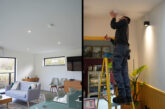
Amendments to Smoke and Carbon Monoxide Alarm (England) Regulations 2015 and Approved Document J means both pieces of legislation will now include socially rented properties, in addition to privately rented homes. Steve Boggis, Trade Business Unit Director for FireAngel, explores how installers can assist landlords in proactively achieving compliance with the new regulations.
Following parliamentary approval of the government’s proposals to extend the requirements for domestic smoke and carbon monoxide (CO) alarms in response to the findings of its domestic smoke and carbon monoxide alarm consultation, these legislative updates aim to achieve greater consistency for all types of rental properties throughout England.
As part of the amendments, private and social landlords will be required to install one smoke alarm on each storey of their property, in addition to the installation of a CO alarm in any room with a fixed combustion appliance, including boilers, fire and water heaters, but excluding gas cookers.
Landlords will also be legally required to install a CO alarm when a fixed combustion appliance is fitted. Whilst gas cookers are not included within the amendments, the British Standards still recommends that a CO alarm is fitted in any property with this type of appliance.
The new regulations will also ensure landlords repair or replace alarms when notified of a fault, but regular alarm testing will remain the responsibility of the resident. The smoke and CO alarms must comply with British Standard EN 50291-1 and carry a British or European approval mark, such as a Kitemark.
Interlinked initiatives
To ensure landlords achieve compliance with the new regulations, whilst also providing the highest possible standards of protection, we advise that electrical contractors should recommend and install interlinked smoke, heat and CO devices.
By fitting Smart RF compatible mains and battery-powered devices throughout an entire property, professionals can assist landlords in achieving an efficient and cost-effective approach to protection that provides the fastest possible warning of a potential fire or CO event. This can be achieved by fitting a Smart RF Radio Module into each device, either upon initial installation or at a later date, to wirelessly interlink every device together. When one alarm sounds, every device on the network sounds, mimicking the chirp of the original smoke or CO alarm that detected the potential danger.
As a hybrid system can be created by meshing both mains and battery-powered devices onto a single network, the requirement for costly and time-consuming channelling or trunking is also eliminated. This enables installers to quickly and safely update the level of protection throughout landlords’ rental properties, without the historical cost and resource implications.
Well connected
By choosing devices that feature connected technologies, the system can also be continuously extended and upgraded to include additional safety products, when required, to provide the highest possible levels of protection, particularly for vulnerable individuals who present the greater potential risk. By installing alarms that include Smart RF technology, a Connected Gateway can be added to an existing network to provide remote real time monitoring of every alarm on the network.
Device data can be accessed via a free App, which can send optional notifications regarding the system’s status to the landlord or other nominated individual. This provides transparent and consistent clarity regarding the level of protection installed throughout a domestic property in relation to the risk level of the individual residing within it.
From a contractor’s perspective, this interconnectivity enables professionals to document the completion of each installation phase and validate the overall installation, as information can be instantly logged via the wireless network. By taking a photograph of each completed installation, the images can be wirelessly uploaded to a centralised platform to generate immediate sign-off, which subsequently produces a certification of fire legislative compliance, in accordance with BS 5839-6.
This intelligent process of confirmation eradicates any requirement for paper-based data capture, ensuring each installation has been adequately assessed for competence and validated to ensure the maximum levels of detection have been achieved, completely revolutionising approaches to documentation and verification.
With the government stating the proposed regulations for England will be passed as soon as legislative time allows, professional installers can adopt a proactive approach to protection by fitting interlinked devices that set the standard for a new generation of fire and CO protection throughout all types of domestic properties.
To browse FireAngel’s portfolio of smoke, heat and CO safety solutions click here










